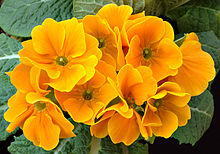- Eudicots
-
Eudicots
Temporal range: Early Cretaceous - Recent
Primula hortensis, a eudicot Scientific classification 
Kingdom: Plantae clade: Angiosperms clade: Eudicots Clades - Ranunculales
- Sabiales
- Proteales
- Trochodendrales
- Buxales
- Core eudicots:
- Berberidopsidales
- Dilleniales
- Gunnerales
- Caryophyllales
- Santalales
- Saxifragales
- Vitales
- Rosids about 16 orders
- Asterids about 10 orders
Eudicots and Eudicotyledons are botanical terms introduced by Doyle & Hotton (1991) to refer to a monophyletic group of flowering plants that had been called tricolpates or non-Magnoliid dicots by previous authors. The term means, literally, "true dicotyledons" as it contains the majority of plants that have been considered dicotyledons and have typical dicotyledonous characters. The term "eudicots" has been widely adopted to refer to one of the two largest clades of angiosperms (constituting over 70% of angiosperm species), monocots being the other. The remaining dicots are sometimes referred to as paleodicots but this term has not been widely adopted as it does not refer to a monophyletic group.
A large number of familiar plants are eudicots. A few are forget-me-not, cabbage, apple, dandelion, buttercup, maple and macadamia.
Another name for the eudicots is tricolpates, a name which refers to the structure of the pollen. The group has tricolpate pollen, or forms derived from it. These pollen have three or more pores set in furrows called colpi. In contrast, most of the other seed plants (that is the gymnosperms, the monocots and the paleodicots) produce monosulcate pollen, with a single pore set in a differently oriented groove called the sulcus. The name "tricolpates" is preferred by some botanists in order to avoid confusion with the dicots, a non-monophyletic group (Judd & Olmstead 2004).
The name eudicots (plural) is used in the APG system, of 1998, and APG II system, of 2003, for classification of angiosperms. It is applied to a clade, a monophyletic group, which includes most of the (former) dicotyledons.
Subdivisions
The eudicots can be divided into two groups: the basal eudicots and the core eudicots. [1] Basal eudicots is an informal name for a paraphyletic group. The core eudicots are a monophyletic group. [2]
A second study has suggested that the core eudicots can be divided into two clades - Pentapetalae - comprising all core eudicots except Gunnerales - and Gunnerales.[3]
Pentapetalae can be then divided into three clades:
- (i) a "superrosid" clade consisting of Rosidae, Vitaceae and Saxifragales
- (ii) a "superasterid" clade consisting of Berberidopsidales, Santalales, Caryophyllales and Asteridae
- (iii) Dilleniaceae
Within the core eudicots, the largest groups are the "rosids" (core group with the prefix "eu−") and the "asterids" (core group with the prefix "eu−").
In more detail, within each clade some unplaced families and orders (unplaced genera are not mentioned):
- clade eudicots
-
-
- family Buxaceae [+ family Didymelaceae]
- family Sabiaceae
- family Trochodendraceae [+ family Tetracentraceae]
- order Ranunculales
- order Proteales
-
- clade core eudicots
-
-
- family Aextoxicaceae
- family Berberidopsidaceae
- family Dilleniaceae
- order Gunnerales
- order Caryophyllales
- order Saxifragales
- order Santalales
-
- clade rosids
-
-
- family Aphloiaceae
- family Geissolomataceae
- family Ixerbaceae
- family Picramniaceae
- family Strassburgeriaceae
- family Vitaceae
- order Crossosomatales
- order Geraniales
- order Myrtales
-
- clade eurosids I
-
-
- family Zygophyllaceae [+ family Krameriaceae]
- family Huaceae
- order Celastrales
- order Malpighiales
- order Oxalidales
- order Fabales
- order Rosales
- order Cucurbitales
- order Fagales
-
-
- clade eurosids II
-
-
- family Tapisciaceae
- order Brassicales
- order Malvales
- order Sapindales
-
-
-
- clade asterids
- clade euasterids I
-
-
- family Boraginaceae
- family Icacinaceae
- family Oncothecaceae
- family Vahliaceae
- order Garryales
- order Solanales
- order Gentianales
- order Lamiales
-
-
- clade euasterids II
-
-
- family Bruniaceae
- family Columelliaceae [+ family Desfontainiaceae]
- family Eremosynaceae
- family Escalloniaceae
- family Paracryphiaceae
- family Polyosmaceae
- family Sphenostemonacae
- family Tribelaceae
- order Aquifoliales
- order Apiales
- order Dipsacales
- order Asterales
-
-
-
-
Note : “ + ....” = optional, as a segregate of the previous family.
References
- ^ Worberg A, Quandt D, Barniske A-M, Löhne C, Hilu KW, Borsch T (2007) Phylogeny of basal eudicots: insights from non-coding and rapidly evolving DNA. Organisms, Diversity and Evolution 7 (1), 55-77.
- ^ Douglas E. Soltis, Pamela S. Soltis, Peter K. Endress, and Mark W. Chase. Phylogeny and Evolution of Angiosperms. Sinauer Associates: Sunderland, MA, USA. (2005).
- ^ Moore MJ, Soltis PS, Bell CD, Burleigh JG, Soltis DE (2010) Phylogenetic analysis of 83 plastid genes further resolves the early diversification of eudicots. Proc Natl Acad Sci USA
- Doyle, J. A. & Hotton, C. L. Diversification of early angiosperm pollen in a cladistic context. Pp. 169-195 in Pollen and Spores. Patterns of Diversification (eds Blackmore, S. & Barnes, S. H.) (Clarendon, Oxford, 1991).
- Walter S. Judd and Richard G. Olmstead (2004). "A survey of tricolpate (eudicot) phylogenetic relationships". American Journal of Botany 91 (10): 1627–1644. doi:10.3732/ajb.91.10.1627. PMID 21652313. (full text )
- Eudicots in Stevens, P. F. (2001 onwards). Angiosperm Phylogeny Website. Version 7, May 2006.
External links
Categories:
Wikimedia Foundation. 2010.
